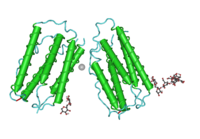
Photo from wikipedia
Background Interferon (IFN)-β induction via activation of the stimulator of interferon genes (STING) pathway has shown promising results in tumor models. STING is activated by cyclic dinucleotides such as cyclic… Click to show full abstract
Background Interferon (IFN)-β induction via activation of the stimulator of interferon genes (STING) pathway has shown promising results in tumor models. STING is activated by cyclic dinucleotides such as cyclic GMP–AMP dinucleotides with phosphodiester linkages 2′–5′ and 3′–5′ (cGAMPs), that are produced by cyclic GMP–AMP synthetase (cGAS). However, delivery of STING pathway agonists to the tumor site is a challenge. Bacterial vaccine strains have the ability to specifically colonize hypoxic tumor tissues and could therefore be modified to overcome this challenge. Combining high STING-mediated IFN-β levels with the immunostimulatory properties of Salmonella typhimurium could have potential to overcome the immune suppressive tumor microenvironment. Methods We have engineered S. typhimurium to produce cGAMP by expression of cGAS. The ability of cGAMP to induce IFN-β and its IFN-stimulating genes was addressed in infection assays of THP-I macrophages and human primary dendritic cells (DCs). Expression of catalytically inactive cGAS is used as a control. DC maturation and cytotoxic T-cell cytokine and cytotoxicity assays were conducted to assess the potential antitumor response in vitro. Finally, by making use of different S. typhimurium type III secretion (T3S) mutants, the mode of cGAMP transport was elucidated. Results Expression of cGAS in S. typhimurium results in a 87-fold stronger IFN-β response in THP-I macrophages. This effect was mediated by cGAMP production and is STING dependent. Interestingly, the needle-like structure of the T3S system was necessary for IFN-β induction in epithelial cells. DC activation included upregulation of maturation markers and induction of type I IFN response. Coculture of challenged DCs with cytotoxic T cells revealed an improved cGAMP-mediated IFN-γ response. In addition, coculture of cytotoxic T cells with challenged DCs led to improved immune-mediated tumor B-cell killing. Conclusion S. typhimurium can be engineered to produce cGAMPs that activate the STING pathway in vitro. Furthermore, they enhanced the cytotoxic T-cell response by improving IFN-γ release and tumor cell killing. Thus, the immune response triggered by S. typhimurium can be enhanced by ectopic cGAS expression. These data show the potential of S. typhimurium–cGAS in vitro and provides rationale for further research in vivo.
Journal Title: Journal for Immunotherapy of Cancer
Year Published: 2023
Link to full text (if available)
Share on Social Media: Sign Up to like & get
recommendations!